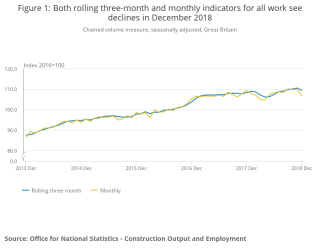Repair & maintenance output decreased by 5.0% in December 2018, compared to November and new work output declined by 1.6%, according to the Office for National Statistics
This is the third consecutive monthly decline seen in the repair and maintenance series and puts the series at its lowest output value since November 2016. All subcategories of the repair and maintenance series have seen declines month-on-month, however the fall is primarily driven by a 5.9% decrease in non-housing repair and maintenance.
Across the fourth quarter, construction output in Great Britain decreased by 0.4% compared to the previous quarter. The fourth quarter decline in output followed a relatively strong period of growth in the third quarter (July to Sept) of 2.1%.
The decrease in Q4 2018 was driven by a 2.8% drop in repair and maintenance, which outweighed a 1.1% increase in new work between Quarter 3 and Quarter 4. The biggest contributors to the fall were private housing and non-housing repair and maintenance, which fell by 4.0% and 2.9% respectively in the most recent period.
December 2018 construction output in Great Britain was £339m lower than in December 2017. Despite this fall, April 2018 remains the lowest point for the year of 2018, with the December value being £250m higher than this period.
Scape Group chief executive Mark Robinson commented: “As a short month we often see a drop in construction output during the month of December, and December 2018 was no exception to that rule. A boom in November and a strong Q3 could have hoodwinked the industry into thinking it was business as usual, but a sharp decrease in all work highlights the need for the government and local authorities to provide greater transparency on project pipelines to ensure business optimism does not dip as we head into 2019.”

Blane Perrotton, managing director of property consultant Naismiths, said: “Few sectors have seen the economic brakes slammed on as hard as construction. Builders’ booming third quarter – in which output rocketed by 2.1% – feels a lifetime away.
“While the final quarter of 2018 can be filed under ‘slowdown’ rather than ‘slide’ – just – such distinctions are moot in an industry which has been stripped of confidence and momentum.
“The prime suspect in construction’s reversal of fortune is its previously gravity-defying house-building sector. A 6.8% drop in new work consigned residential construction to also-ran status, with what little growth there was coming from commercial and infrastructure work.
“Against this grim backdrop, confidence is ebbing away. Last week’s PMI data showed sentiment has plunged back towards the deep-frozen lows of last March, and official insolvency figures confirm nearly 3,000 construction firms went to the wall in 2018; the highest failure rate of any business sector.
“Labour shortages and rising material costs are eating into margins, and intense competition for the little work that is being put out to tender is forcing contractors to bid painfully low.
“Among developers, the sense that a messy ‘no deal’ Brexit is now a very real danger has choked off demand, and where investment can be deferred, it is. Barring an improbable, miraculous resolution to Britain’s Brexit deadlock in coming weeks, this painful inertia is set to continue.”
Got a story? Email news@theconstructionindex.co.uk



